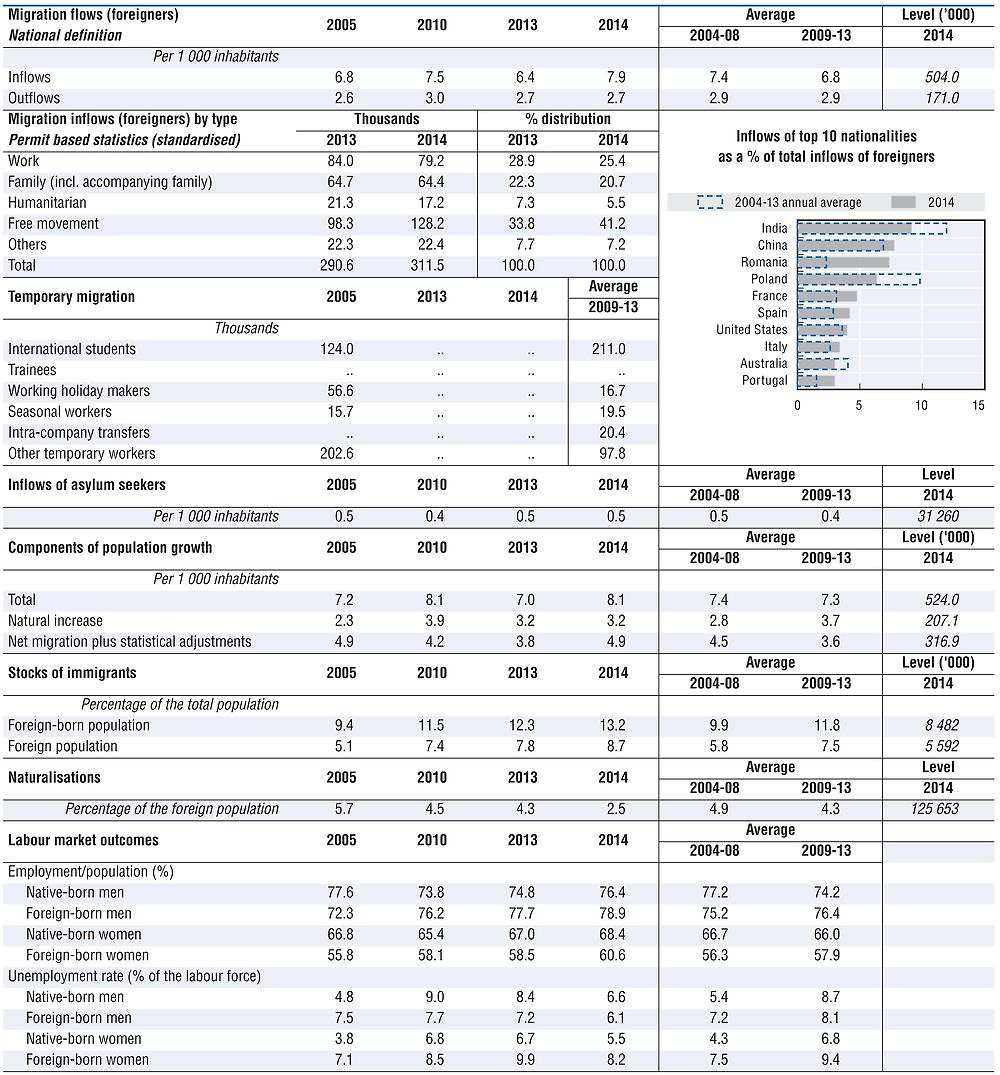United Kingdom
Immigration – which had more or less plateaued in the past few years – increased sharply in 2014 to 632 000. The outflow of 320 000 in 2014 was similar to the year before. The net outflow of 55 000 British citizens, similar to 2013, was more than compensated for by a net inflow of 367 000 non-British, 98 000 more than the year before. The main reasons given for migrating in 2014 by the non-British were work (44%) and study (36%).
The number of work-related visas (including dependents) decreased by 1% in 2015 to 166 000. The trend in Tier 1 work visas issued (-45%, 5 400 visas in 2015) contrasted with that of visas issued to skilled workers with a job offer under Tier 2 (and their dependents) as well as those issued under Tier 5 (youth mobility and temporary workers) +2% each, to 92 000 and 45 000, respectively.
Among Tier 2, 59 000 work visas were issued in the ICT categories. Sponsored visa applications for skilled work (Tier 2) increased by 3% to 56 000 in 2015 (main applicants). The Information and Communication sector alone (+3%) accounted for 42% of all skilled work-sponsored visa applications.
The number of work-related extensions of stay (including dependants) continued to fall, from 88 400 in 2014 to 80 200 in 2015. Around 59 000 of these were extensions for skilled work (-3% compared with 2014). Of the 35 000 extensions in Tier 2 (main applicants), some 23 400 were previously in Tier 2 (i.e. skilled work), 5 600 and 5 400 were grants to former students and individuals previously in the Tier 1 – Post-Study Work category (now closed to new entrants), respectively.
In 2015, the number of study-related visas granted fell to 210 400 (-4%); of the recipients, 15 000 were dependents. This trend results from government attempts to curb abuse of the student entry route. The university-sponsored study visa applications were the category least affected by the trend, with a 1% decrease to 166 400.
The number of people granted permission to stay permanently, which fell by about a third in 2014, decreased by 14% in 2015 to reach 90 000 in 2015, the lowest level since 2000. Forty-four per cent of grants in 2015 were for employment, 20% for asylum and 18% for family reasons – half its 2014 level.
According to Eurostat data, there were 38 900 asylum applications in 2015 (including dependents), i.e. 3% of the applications received in the EU28. This number increased 20% compared with 32 300 received in 2014. The top three origin nations (Eritrea, Iran and Pakistan) accounted for 28% of total applications. Around 36% of decisions made at first instance were positive, compared with 51% in the EU28.
Following most of the recommendations formulated by the Migration Advisory Committee, the government has begun to implement a major reform of Tier 2, which should be fully in place by April 2017. As a means of decreasing the number of migrants eligible under Tier 2 (general), salary thresholds will be increased to GBP 30 000 by 2017, with some exemptions. Non-EEA nurses have been put on the shortage list but will need a labour market test. All entries of ICT migrants will be conditional on a minimum salary threshold of GBP 41 500. Some conditions for extending the stay of those with higher salaries will be relaxed from April 2017. With certain exceptions, an immigration skills charge of GBP 1 000 per person per year will be implemented from April 2017.
In September 2015, the government announced an extension of the Vulnerable Persons Relocation Scheme to Syrian refugees, to resettle up to 20 000 refugees from Syria’s neighbouring countries over the next five years. Separate from those who claim asylum in the United Kingdom, a temporary concession allowing Syrians already in the United Kingdom to apply for an extension to their visa, or to switch to a different visa category, has been extended until February 2017.
To encourage integration, in January 2016 the government announced a new English language requirement for the family immigration route at level A2 of the Common European Framework of Reference for Languages. Non-EEA partners and parents now have to meet a pre-entry A1 requirement for a visa and a B1 requirement for settlement. Only then may they qualify, after two and a half years in the United Kingdom, for further leave to remain on a five-year route to settlement. The new A2 requirement will not be implemented before October 2016.

